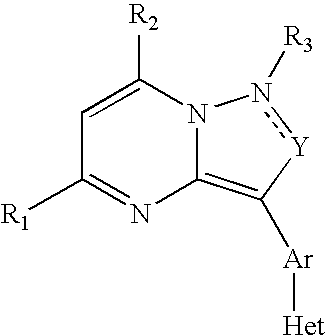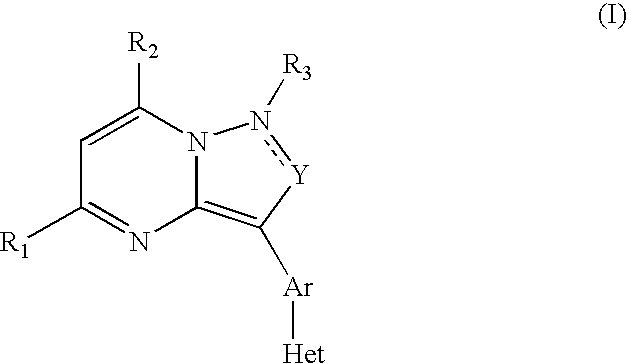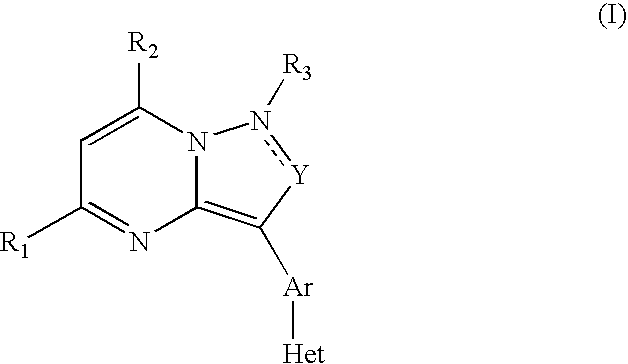Crf Receptor Antagonists and Methods Relating Thereto
- Summary
- Abstract
- Description
- Claims
- Application Information
AI Technical Summary
Benefits of technology
Problems solved by technology
Method used
Image
Examples
example 1
7-(2-Methoxy-phenyl)-3-(2-methoxy-4-pyrazol-1-yl-phenyl)-2,5-dimethyl-pyrazolo[1,5-A]pyrimidine
[0104]
Step 1A:
[0105] To a cooled suspension of methyl 4-amino-2-methoxybenzoate (6.82 g, 37.7 mmol) in 6N HCl (aqueous) was added a solution of sodium nitrite (2.60 g, 37.7 mmol) dropwise. After stirring at 0° C. for 20 min, stannous chloride dihydrate (24.7 g, 109.3 mmol) was added portionwise. The resulting suspension was stirred at 0° C. for 1.5 hr prior to filtration. The collected solid was suspended in EtOH to which malonaldehyde bis(dimethyl acetal) (7.5 mL, 45.7 mmol) was added, and this reaction mixture was subjected to reflux overnight. After evaporation of EtOH, the residue was extracted between EtOAc and water, and the organic phase was dried and evaporated to dryness. The residue was passed through a silica gel plug (25% EtOAc / hexane) to yield Cmpd 1b (7.43 g) as a mixture of the methyl and ethyl benzoate.
Step 1B:
[0106] To a solution of 1b (10.6 g) in dry diethyl ether (...
example 1a
Alternate Synthesis OF INTERMEDIATE 1f
[0112]
Step 1A-A:
[0113] To a 3-neck flask equipped with a mechanical stirrer was charged 250 g (1.12 mol) of 2-methoxy-4-acetylaminobenzoic acid methyl ester followed by 1 L of methanol. Agitation was started and 94 mL (3.36 mmol, 3 eq.) of concentrated sulfuric acid was slowly added creating a slight reflux. The mixture was stirred for 24 hr. The mixture was concentrated in vacuo affording a thick slurry. The slurry was filtered using a Buchner funnel and washed with 300 mL of cold methanol. The filter cake was collected and dried in vacuo at 45° C. for 24 hr affording 302 g of 1a as a hemi-sulfate salt in a 96% yield.
Step 1A-B:
[0114] In a 2 L three-neck Morton flask equipped with a mechanical stirrer and thermocouple was charged 200 g (716 mmol) of methyl 4-amino-2-methoxybenzoate 1a. The solid was slurried with 700 mL of 6N hydrochloric acid and chilled in an ice-bath. To the mixture was charged dropwise 54.3 g (788 mmol, 1.1 eq.) of sod...
example 2
7-Isopropyl-3-(2-methoxy-4-pyrazol-1-yl-phenyl)-2,5-dimethyl-pyrazolo[1,5-a]pyrimidine
[0122]
Step 2A:
[0123] To a solution of Cmpd 1f (1.41 g, 4.0 mmol) and Fe(acac)3 (424 mg, 1.2 mmol) in THF / NMP (v / v=8:1) was added iPrMgCl (2.0 M in THF, 4.0 mL) slowly at room temperature. The reaction mixture was stirred for 1.5 hr before quenched with 1N HCl (aq.). After extraction with EtOAc, the crude product was purified by column chromatography (25% EtOAc / Hexane) to yield Cmpd 2-1 (628 mg.)
[0124] Depending on the alkyl functionality in the alkyl magnesium halide, the compounds listed in the following table were synthesized:
HPLCCmpdR2MWMStRMethod2-1361.4473611.28642-2375.4743751.49942-3333.3933331.54242-4375.4743751.27842-5389.5390.28.49022-6347.423486.51422-7415.4174157.88022-8409.4914096.28022-9427.4814288.24022-10443.9364448.79022-11461.9264628.74022-12427.4814288.24022-13443.9364448.75022-14443.9364448.66022-15427.4814288.24022-16361.4473612.70012-17488.3874888.9202
PUM
| Property | Measurement | Unit |
|---|---|---|
| Composition | aaaaa | aaaaa |
| Disorder | aaaaa | aaaaa |
Abstract
Description
Claims
Application Information
 Login to View More
Login to View More - R&D
- Intellectual Property
- Life Sciences
- Materials
- Tech Scout
- Unparalleled Data Quality
- Higher Quality Content
- 60% Fewer Hallucinations
Browse by: Latest US Patents, China's latest patents, Technical Efficacy Thesaurus, Application Domain, Technology Topic, Popular Technical Reports.
© 2025 PatSnap. All rights reserved.Legal|Privacy policy|Modern Slavery Act Transparency Statement|Sitemap|About US| Contact US: help@patsnap.com



